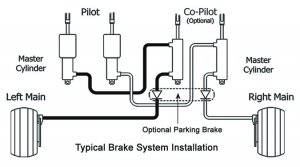The left pedal is for brake(s) on the left side of the aircraft only, and likewise the right pedal for the right side.
We use two pedals because it is common where differential braking are applied, in other words different amount of braking on the two sides of the aircraft.
This is handy for maneuvering the aircraft around corners. For example if the plane needs to be turned to the left 90 degrees to enter a taxiway, and the length of the fuselage is long, applying left brake during the turn can reduce the turn radius, making it possible to turn without the outer set of wheels running onto the grass.
During a normal landing rollout, equal amount of pressure is applied to both pedals. The difference between both pedals caused by human application is minimal and does not have an observable effect.
Usually, only the pilot flying would be operating the controls, therefore only the pilot flying would apply the brake pedals. Except in an emergency where stopping distance is critical, the pilot monitoring may apply pressure to his own pedals to ensure maximum braking is achieved.

